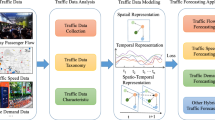Abstract
This paper makes the first step towards mining citywide traffic congestion correlation by utilizing traffic related information from social media. Traffic congestion correlation mining, namely studying which road segments close to each other are highly likely to occur congestion simultaneously, is especially important to help many real applications, such as traffic prediction, traffic control, and urban transportation planning. Traditional traffic data collected from various sensors and other equipments are costly to obtain and hard to scale up to cover a entire city. With the rising popularity of social media, it is common for the public transportation systems and governments to share real time traffic information with the public through social media. It provides us great opportunities to study the traffic conditions of a city with the rich and easily available online data. However, it is also very difficult to use social media data to mine the citywide traffic congestion correlation due to the following major challenges: (1) Social media data like tweets in Twitter are usually noisy and hard to process, especially those tweets posted by individuals. (2) There lacks a method to study the citywide traffic congestion correlation. In this paper, instead of crawling all the traffic related tweets of a city, we only focus on utilizing the tweets posted by some particular organizations or governments. Tweets posted by them are more accurate and formal, thus it is much easier for traffic information extraction. We regard the traffic congestion correlation mining task as a spatio-temporal frequent pattern mining problem by considering each tweet reporting the traffic congestion of a particular road segment as a spatio-temporal item. A spatio-temporal frequent pattern mining algorithm TC_Apriori is also proposed to discover the road segment co-occurrence patterns in congestion. We use the tweets reporting the traffic information of Chicago to evaluate the proposed approach, and the results show that the proposed approach can effectively discover the road segment co-occurrence patterns in congestion.









Similar content being viewed by others
References
Schrank, D., Eisele, B., & Lomax, T. (2012). urban mobility report powered by inrix traffic data. Technical report, 2012.
Shang, J., Zheng, Y., Tong, W., Chang, E., & Yu, Y. (2014). Inferring gas consumption and pollution emission of vehicles throughout a city. In ACM SIGKDD conference on knowledge discovery and data mining.
Kim, Y. G., Shiravi, A., Min, P. S. (2006). Congestion prediction of self-similar network through parameter estimation. In network operations and management symposium (pp. 1–4). IEEE.
Beukesa, E. A., Vanderschuren, M. J. W. A., & Zuidgeest, M. H. P. (2011). Context sensitive multimodal road planning: A case study in cape town, South Africa. Journal of Transport Geography, 19(3), 452–460.
Johnston, R. A. (2004). The urban transportation planning process. Number 115-138. The Guilford Press, New York City.
Henry, J. J., Farges, J. L. (2004) Traffic congestion control//control, computers, communications in transportation. In Selected Papers from the IFAC/IFIP/IFORS symposium (Vol. 177). Elsevier.
Min, W., & Wynter, L. (2011). Real-time road traffic prediction with spatio-temporal correlations. Transportation Research Part C Emerging Technologies, 19(4), 606–616.
Pan, B., Zheng, Y., Wilkie, D., Shahabi, C. (2013). Crowd sensing of traffic anomalies based on human mobility and social media. In Proceedings of the 21st ACM SIGSPATIAL international conference on advances in geographic information systems (pp. 344–353).
Tao, S., Manolopoulos, V., Rodriguez, S., & Rusu, A. (2012). Real-time urban traffic state estimation with A-GPS mobile phones as probes. Journal of Transportation Technologies, 2(1), 22–31.
Muñoz, L., Sun, X., Horowitz, R., & Alvarez, L. (2003). Traffic density estimation with the cell transmission model. In the 2003 American control conference
Ozkurt, C., & Camci, F. (2009). Automatic traffic density estimation and vehicle classification for traffic surveillance systems using neural networks. Mathematical and Computational Application, 14(3), 187–196.
Zheng, Y., Capra, L., Wolfson, O., & Yang, H. (2014). Urban computing: Concepts, methodologies, and applications. CM Transactions on Intelligent Systems and Technology, 5(3), 38.
Bregman, S. (2012). Uses of social media in public transportation. Washington: Transportation Research Board.
Endarnoto, S. K., Pradipta, S., Nugroho, A. S., & Purnama, J. (2011). Traffic condition information extraction and visualization from social media twitter for android mobile application. In international conference on electrical engineering and informatics
Cao, H., Mamoulis, N., & Cheung, D. W. (2005). Mining frequent spatio-temporal sequential patterns. In IEEE international conference on data mining.
Tsoukatos, I., & Gunopulos, D. (2001). Efficient mining of spatiotemporal patterns. SSTD, 2121, 425–442.
Agrawal, R., & Srikant, R. (1994). Fast algorithm for mining association rules. In Proceedings of the 20th VLDB conference.
Author information
Authors and Affiliations
Corresponding author
Rights and permissions
About this article
Cite this article
Shen, D., Zhang, L., Cao, J. et al. Forecasting Citywide Traffic Congestion Based on Social Media. Wireless Pers Commun 103, 1037–1057 (2018). https://doi.org/10.1007/s11277-018-5495-x
Published:
Issue Date:
DOI: https://doi.org/10.1007/s11277-018-5495-x




